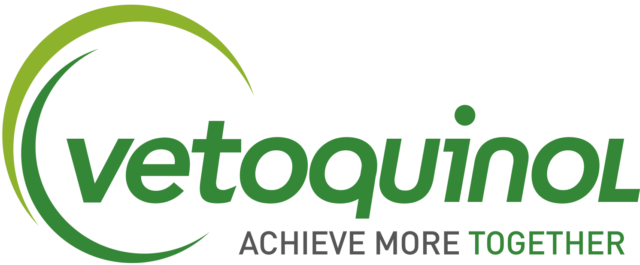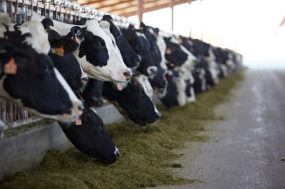1. Can charcoal close the door on antibiotics?
Published September 2018
Consumer requests and a regulation change to the use of medication in animal feed are driving livestock producers to consider natural alternatives to aid in herd health.
Carbon in the form of activated charcoal is a natural element cattle producers are feeding in hopes of improving animal health.
Activated charcoal absorbs and excretes toxins that can have a negative effect on the gut, thus improving the health and production of animals that consume it.
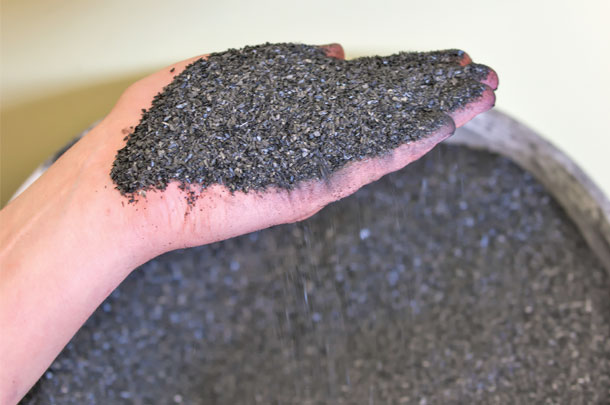
In addition, research is showing feeding activated charcoal can reduce the amount of methane produced by the animal and improve the soil to which the manure is applied.
“We already know biochar enhances the quality of soils,” Kathleen Draper says. “Reducing nitrogen leaching into groundwater, possible nitrous-oxide emission reduction, beneficial microbe numbers and serving as a binder for molds and mycotoxins are all factors that can reduce environmental strain.”
Why is biochar more impactful in areas with low rainfall or nutrient-poor soils?
Biochar can address a number of different growing constraints, including drought conditions or nutrient-poor soils. Applying biochar in areas impacted by low rainfall can benefit soils in different ways depending on soil type.
Sandy soils tend to drain quickly, and biochar can help retain water so plants can utilize it over longer periods of time. Clay soils in drought areas can benefit from biochar in that it can improve infiltration.
Some studies have found plant roots to be longer, which also helps with water harvesting and transpiration. Biochar has also been found to reduce soil cracking in clay soils.
The high porosity in many types of biochar helps to retain nutrients for longer periods of time as well. It should be noted biochar should always be blended with a nutrient source (e.g., compost) prior to application.
—Kathleen Draper, U.S. director, Ithaka Institute for Carbon Intelligence
PHOTO: Fine powder-activated charcoal is an available feed ingredient to naturally absorb toxins from within a cow’s digestive system. Photo provided by Ron Bricker, PMT Inc.
Read story here: Can charcoal close the door on antibiotics?
2. Brinkes cut milking time in half with new rotary parlour
Published January 2018
In 2016, Remco and Karen Brinke, along with his parents, Ben and Annemieke, built a new parlour, holding area and herd management area adjacent to the existing freestall barn on their farm in Granton, Ontario.
The parlour is a 40-stall internal rotary, which is large enough to support the current herd as well as future growth in cow numbers.
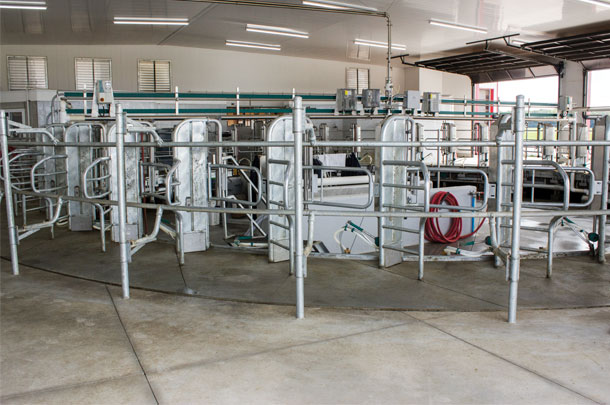
It replaced a low-cost, double-10 parlour built in 2004 that required four hours to complete a milking shift.
Overall, the new parlour “provides consistent cow and workflow, and a stress-free environment for both the animals and the milkers,” Brinke says.
They regularly milk 190 cows per hour, and with a herd of 300 to 315 milking cows, they are done with milking and washdown in two hours or less.
The new sort area beyond the parlour has more room to work than his previous space. There is water access, a small straw pen and a row of headlocks.
Extra gating allows Brinke to separate groups of cows within the sort area. Herd work only lasts about 30 minutes and most days, the cows are all back in their pens by 7:30 a.m. The morning milking starts at 5 a.m.
With the new parlour now operating for two years, what is the next big improvement you are considering for your farm?
With the improvements gained from the new parlour, we reviewed where our next bottlenecks were on our farm. Between a large slug of calves this fall and quota growth from the past two years, we foresaw problems in our calf, dry cow and heifer spaces.
This summer we had many heifers off-site, housed in a mixture of pasture, a rented barn and custom-raised. In June, we added more calf suites in the calf barn and, this spring, started building a new barn to house all heifers from weaning to pre-calving.
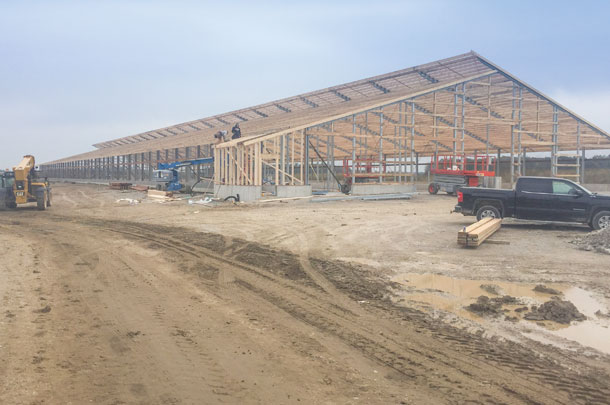
Once the new barn is finished, we will be adding more straw pack for calving and a small post-calving group. With these changes, we hope to be set for the next five years.
—Remco Brinke, dairy producer, Lintfield Farms
PHOTO 1: A new 40-stall internal rotary parlour has increased the efficiency of milking cows at Lintfield Farms in Granton, Ontario. Photo by Karen Lee.
PHOTO 2: The newest building project under construction at Lintfield Farms is a heifer barn for animals from weaning to pre-calving. Photo by Remco Brinke.
Read story here: Brinkes cut milking time in half with new rotary parlour
3. What’s with these navels? What we know and what we don’t
Published August 2018
While navel infections in calves are known to decrease a calf’s growth rate by about 100 grams per day, little is known about the best methods for preventing this fairly common disease.
Navel dipping may be one effective method, and many farms already report regularly navel dipping their calves; however, more research is needed to determine the effectiveness of this practice and best methods for doing so.
At present, the research does show keeping a newborn calf in a clean environment and providing the calf with good-quality colostrum can help reduce a calf’s chance of navel infection.
In addition, regularly examining the navel can help producers catch and treat the infection early, reducing the negative impact it has on the calf.
These clinical exams should be done in the first three weeks of life, while the calf is most vulnerable to an infection.
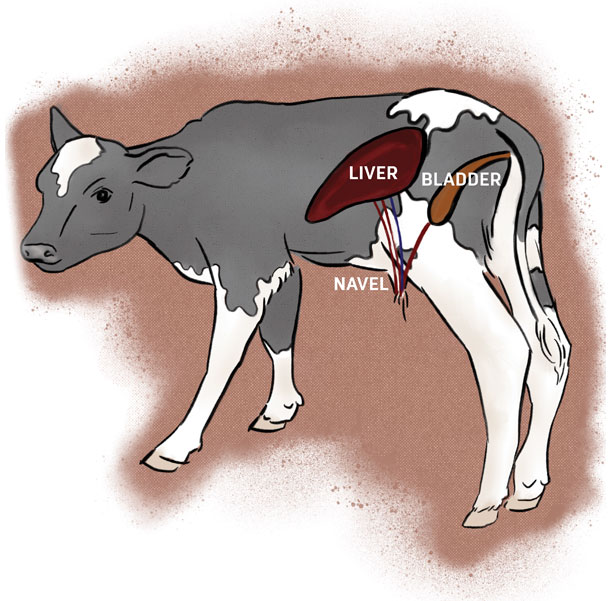
Given what we do and don’t know, what’s the next step for navel dipping and care research?
Previous research has identified some factors that led to navel infections, but we need to understand more about how these happen and how commonly they occur on Canadian dairy farms.
We also need to develop a better understanding of how well navel dipping works and, if it works, know how frequently it should be applied. Over the next number of years, we hope to conduct additional studies at the University of Guelph.
—David Renaud, assistant professor/consultant, University of Guelph
Illustration: Illustration by Kristen Phillips.
Read story here: What’s with these navels? What we know and what we don’t
4. Leading the way: 5 tips to be an exceptional showmanship judge
Published May 2018
When it comes to youth dairy competitions, showmanship is the ultimate test of a junior exhibitor’s animal handling skills, knowledge of their project and preparation.
Katie Coyne, an experienced showmanship judge herself, offered guidelines for others to bring greater consistency to the task of evaluating and placing these classes.
From approaching the ring with a “game plan” to keep the show running smoothly to asking questions appropriate for each level and brushing up on the uniform guidelines, Coyne encouraged fellow judges to take their responsibilities seriously.
However, she also reminded them to approach the ring with the mindset of providing encouragement and helping youth learn and succeed.
The article went hand-in-hand with a clinic you helped spearhead for showmanship judges at the 2018 World Dairy Expo. Describe key points covered and what you hope participants took away from the event.
Key points we covered were: basic showmanship guidelines, proper presentation including appropriate dress for the exhibitor, a halter that fits correctly and the best way to hold the excess lead strap.
Then we got into actually judging a few mock classes. We taught how to work a ring when participants are on the outside of the ring, how to observe exhibitors as they enter the line and setting up in line.
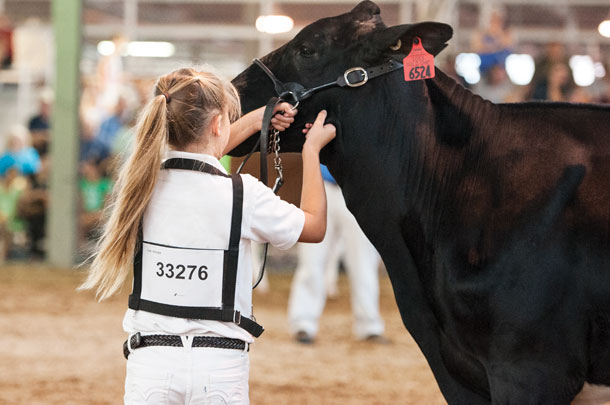
Our primary goal was to “catch the judges up” with the youth who have been diligent in learning the specifics of great showmanship for the past several years.
We also want to bring a consistency to showmanship judging that has not been present in recent years.
—Katie Coyne, dairy youth consultant
PHOTO: Judging showmanship is not about waiting for a misstep to occur or to point out mistakes; it’s about teaching and developing youth. Courtesy photo.
Read story here: Leading the way: 5 tips to be an exceptional showmanship judge
5. Young couple stuck with it to build a dairy of their dreams
Published February 2018
Almost five years ago, Brad and Iris Vink purchased a farm in Embro, Ontario, with 50 milking cows and 55 kilograms of quota. It had a single-12 parlour retrofitted into an old bank barn. Since this facility was limited in terms of expansion, the Vinks opted to build a new barn.
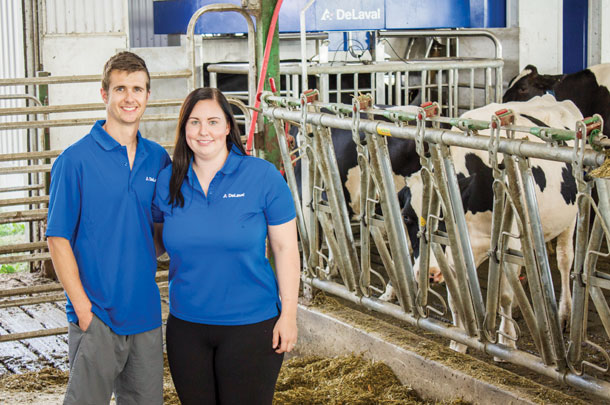
They knew they wanted to milk three times a day but didn’t want to hire employees, so they purchased three gently used automated milking systems from another Ontario farm and started to put up a new freestall barn.
In anticipation of the new building, they began to acquire more quota and cows.
They were milking 110 cows 3X by themselves for two months before the new robot barn was complete. “We ate, slept and milked cows,” Iris says of that time period.
One year later, the robots are milking 115 cows while the Vinks are able to handle the rest of the farm work themselves.
Brad spends his time hoof trimming, breeding and feeding, and Iris does more with the robots and herd health.
How has your farm continued to change over the past year?
We learned to specialize in our strengths instead of us both dabbling in everything. Iris is really good with management, computer work and taking care of the full picture of the farm.
I am more delegated to hands-on tasks and repairs. We found the things I hate, she doesn’t hate as much and vice versa.
As a young couple getting started, dairy farming has been a relationship-building experience. We’ve seen the better side of each other come out. At the same time, we’re so close to each other all day, we found we also need alone time.
Otherwise, we haven’t really changed a whole lot. The robots are still going pretty good. We did put up a separate bay for the cardboard bedding. If you leave it in the pile it was dumped in, it can heat up. We needed a bigger area to spread it out and keep it dry.
We also put rubber mats on the slats. It seemed like the bigger cows were pivoting and turning a little more aggressively, and we felt their toes were getting pinched in the slats.
Ever since we put the rubber on, it’s been better. I do all of the hoof trimming, so I could see ulcers that had healed on their own.
—Brad Vink, dairy producer, Incroft Farms
PHOTO: Brad and Iris Vink are the only two employees on their farm thanks to the help from three robots that milk the farm’s 115 cows. Photo by Karen Lee.
Read story here: Young couple stuck with it to build a dairy of their dreams
6. EcoDairy adopts new feeding systems for cattle and calves
Published January 2018
EcoDairy, near Abbotsford, British Columbia, focuses on agritourism and research. The farm recently adopted two new feeding systems.
The first is a fully automated hydroponic system to grow wheat or barley with light, water and a controlled climate. The plants are harvested at 6 to 8 inches every six days. The 800-square-foot footprint grows the equivalent of 20 acres or more per season.
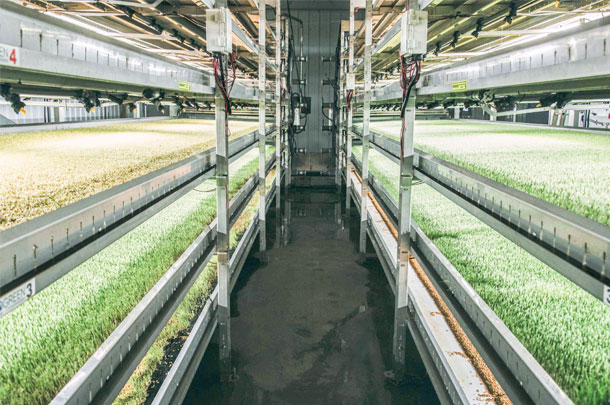
Another new technology recently adopted at EcoDairy is an automated calf rail system for feeding young calves. The calves are housed in individual pens made with movable panels to facilitate the cleaning process.
A rail between pens delivers 2.5 litres of milk or milk replacer to each calf five times per day.
Farm owner Bill Vanderkooi says this system “takes feeding to a new level,” stating that not only is it labour-saving, but it also encourages better growth rates, has better health benefits and lessened the mortality rate of young calves. Water is also provided automatically to each calf.
Have you been able to expand your hydroponic feed system for your dairy herd?
Currently, all of the Hydrogreen grass produced at the EcoDairy is fed to our grass-fed beef finishers.
We have a plan for 2019 to set up an additional system to supply the dairy and to conduct feeding trials to evaluate both performance and economics of dairy feed applications at different feeding levels and to replace forage, grain and a combination of forage and grain.
—Bill Vanderkooi, dairy producer, EcoDairy
PHOTO: In this 800-square-foot hydroponic greenhouse, Bill Vanderkooi can grow 20 acres or more per season. Photo courtesy of Nutriva.
Read story here: EcoDairy adopts new feeding systems for cattle and calves
7. Milk-based calf starter promotes growth on lower-level milk programs
Published November 2017
Grand Valley Fortifiers ran an on-farm trial during the summer of 2016 to evaluate a milk-based pelleted calf starter feed as a supplement to a conventional milk replacer and pelleted calf grower program.
The objective was to compare intake, growth and health parameters of dairy calves during the pre- and post-weaning periods that were fed high or low levels of milk replacer with or without the supplementation of this milk-based pellet.
The research shows calves fed a lower level of milk replacer along with a milk-based pre-starter pellet consume more solid feed and maintain higher average daily gain (ADG) before and after weaning than calves on a conventional lower-level milk program.
Intake did not differ significantly between the 12-litre treatment groups but was significantly less than their 6-litre counterparts.
The researchers hypothesized this lack of response was due to the fact calves were only fed milk-based pellets for the first month of life when calves on accelerated milk level programs do not usually consume adequate solid feed until the second month of life.
You mentioned further research is needed to continue feeding milk-based pellets alongside the traditional calf starter during the weaning process. Have you been able to conduct this study?
We have not run any further controlled research at this point. However, field observations and testimonials have provided insight to us.
Producers report to us feeding the milk-based pellet results in easier weaning of calves with little to no growth slump.
Multiple producers are using the product to increase total nutrient intake by offering the milk-based pellet to calves that did not consume all the milk offered, likely due to poor appetite and limited stomach capacity.
In one instance, a producer on a robotic milk feeder was having issues with cross-suckling. Our approach was to supplement the milk-based pellet, reduce the total milk allowance and alter meal patterns.
We were able to reduce the cross-suckling in a cost-effective manner and maintain growth parameters.
We hope to do a controlled trial shortly to investigate the biological mechanisms in the calf that may explain the improvement in weaning success we are observing in the field.
—Amy Sova, associate dairy nutritionist, Grand Valley Fortifiers
Read story here: Milk-based calf starter promotes growth on lower-level milk programs
8. Pre-hydrate calves for optimal performance
Published February 2018
Most calf illnesses are complicated by dehydration. A proactive approach of pre-hydrating calves will minimize the impact of dehydration and will contribute to a faster recovery and lower antibiotic use.
At Henro Dairy, the calf-feeding protocols highlight the timing, amount and nutrition intake of all liquid feedings (colostrum, transitional milk, pasteurized whole milk and electrolytes) prior to the health event.
Dairy producer Rose Keunen explained how the success of colostrum feeding is based on timing, quantity, quality, cleanliness and temperature.
All calves will then receive four feedings (two days) of transitional milk after receiving two feedings of first colostrum. On day four, calves will receive two servings (3.25 litres each) of pasteurized whole milk.
When setting out the bottles in the single-calf hutches, every calf will be examined for certain clinical parameters. These clinical parameters are nasal discharge, ocular discharge, ear position, coughing, feces, navel, temperature and, most importantly, calf behaviour.
If any abnormalities are noticed, electrolytes will be given to the calf at lunch and repeated for the next few days.
When electrolytes are introduced to the calf at time of change in calf behaviour before the clinical disease occurs, it is referred to as pre-hydrating. At that time, the calf’s metabolism is still good, and the intestines absorb the salts and water better.
Do you pool your transitional milk, or does each calf receive milk from its dam?
Pooling transitional milk is less desirable, as the milk components change rapidly from the second to third milking of a fresh cow.
Larger volumes of third milking can dilute the smaller volume of high concentrations of immunoglobulins, solids, protein, fat and vitamins from the second milking.
Two feedings of colostrum followed by four feedings of transitional milk is your first line of defense against cryptosporidiosis, rota and coronavirus.
When feeding transitional milk, all the second milking must be consumed before using the third milking. Pooling transitional milk increases the risk of contaminating the milk batch from one infected cow, infecting many calves.
It’s a good farm practice to refrigerate or freeze colostrum and transitional milk in containers, labelled with the number of the cow and number of milking.
The overall health and survival of newborn calves will increase by paying meticulous attention to harvesting, storing and feeding colostrum and transitional milk.
—Rose Keunen, dairy producer, Henro Dairy Farms
Read story here: Pre-hydrate calves for optimal performance
9. Designing robotic milking facilities for non-lactating and transition cow management
Published October 2017
Automated milking architect Jeff Prashaw’s facility design for both lactating and dry cows, as well as heifers, offers the benefits of fewer movements and regroupings, all of which result in higher milk production and greater labour efficiency.
Dedicated pens make it easier to manage groups for specific needs, and the introduction to the milking robot in the pre-fresh phase leads to familiarity and lower stress when moved to a lactating group.
The free-flow design includes four pens for lactating groups, including a first-lactation fresh heifer pen with a bedded pack. A pack area is also provided in the close-up pen and the calving pens.
A portion of the barn is devoted to breeding-age and far-off heifers with freestall beds for acclimation.
Drover lanes connect these areas for easy and low-stress pen movements, and a centralized milking and work area with a vet room add to the convenience of the layout.
What more have you learned about designing robot facilities to also accommodate non-lactating cow and heifer groups?
Since the writing of this article, we have only learned through experience that keeping cows of all ages in or around the robot facility and robot is critical to the dairy producer who wishes to push the limits of milk production.
Most notably, introducing pre-fresh and fresh heifers and cows to the robot facility and robot will result in lower stress levels when her milk becomes salable, therefore increasing the chance she will have better letdown, faster milking and, most importantly, hit her peak level of production sooner and sustain that high level longer.
Additionally, we have found calves fed on group robot feeders generally assimilate better to the robot milker than calves not raised this way.
But this approach may not be for everyone. There can be uncontrollable limitations such as budget, space availability or capabilities of management.
There may be self-imposed limitations such as lack of desire, non-aggressive productivity, future plans or balancing trade-offs.
On that last point, I have never been a part of a project where every wish or desire could be incorporated into the design within reason.
A rational and successful design process starts with intense and uninhibited reflection to identify the problems to be solved. Think freely here.
Next, we think of design elements that will solve those problems. Then, and this is the hard part, the elements are amalgamated into a complete facility.
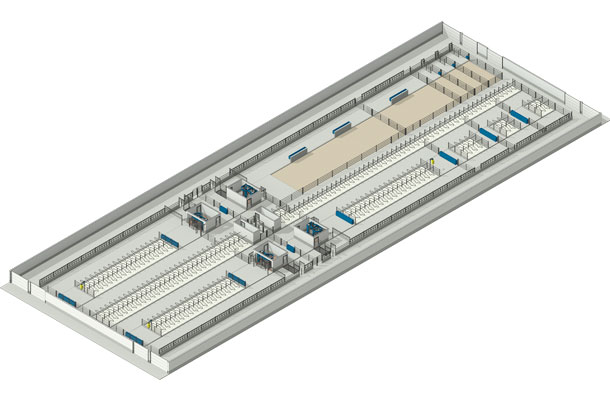
However, the interplay of certain elements results in low- or non-functional situations.
Enter trade-offs. The best way to deal with these trade-offs is to understand the pluses and minuses of each condition, then decide which direction to go.
That is where an agricultural architect, engineer or designer can greatly enhance the experience of realizing your next project.
—Jeff Prashaw, project design manager, DeLaval Inc.
PHOTO: 3D rendering of a relatively modest robotic facility design with non-lactating and transition heifer and cow.
Read story here: Designing robotic milking facilities for non-lactating and transition cow management
10. Non-antibiotic alternatives may effectively treat digital dermatitis
Published August 2018
While at the University of Calgary, Casey Jacobs conducted a study of two commercially available topical applications used to treat digital dermatitis and their ability to regress lesions and prevent recurring cases of the lameness-causing disease.
Comparing Tetracycline 250, Intra HoofSol Liquid, HealMax and 0.9 percent saline solution (control), she found lesion recurrence was equivalent among all treatments at all weeks, ranging from 4 to 12 percent of active lesions developing from chronic lesions.
She also concluded the simple action of cleaning hooves by hosing them in the parlour could help clinically cure digital dermatitis without any topical treatments.
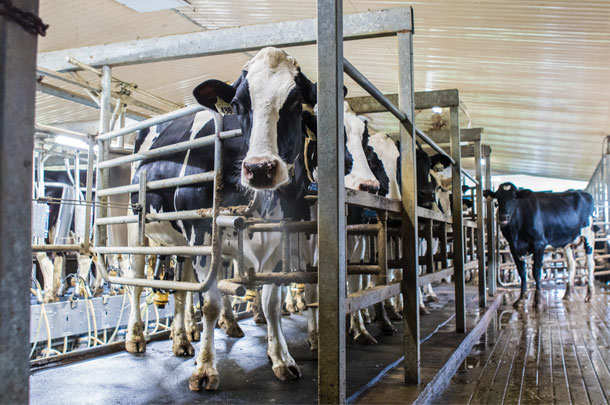
On the dairies you work with that have minimal DD, are they washing feet and, if so, how often?
There are a handful of farms I work with that have incorporated hosing feet on a routine basis varying from every milking (where they have a system in place to clean feet automatically) to once per week.
This not only helps prevent lesions from developing by removing caked-on manure (and bacteria) but also provides an opportunity to identify any active (M1, M2, M4.1) lesions that can benefit from additional treatment.
Start with hosing feet off in the parlour once per week to see how it can be incorporated into your milking routine and make sure to take note of which cows have lesions and should be treated in the trimming chute.
Combining improved foot hygiene, an appropriate footbath protocol for lactating and dry cows and prompt treatment of active lesions can improve DD control.
—Casey Jacobs, animal care specialist, Nutrisource
PHOTO: Spraying feet off in the milking parlour is a great way to detect digital dermatitis lesions. These cows can either be sorted out for treatment or a topical product can be sprayed on the lesion. Photo by Mike Dixon.
Read story here: Non-antibiotic alternatives may effectively treat digital dermatitis
11. Considerations when choosing a compost-bedded pack system
Published October 2017
In this article, Valérie Martin and Steve Adam from Valacta summarized data collected from six farms in Quebec and Ontario, validating six key elements to consider when working with a compost bedded pack system: space, bedding type, pack management, ventilation, economic considerations and animal health.
Noted benefits from the surveyed farms were the impact on cow comfort and its effect on longevity, lower storage costs, easier manure management and lower spreading costs (not to mention the reduction in odour during spreading).
Disadvantages included the supply and cost of bedding materials, dust generated during straw chopping and fuel costs (depending on machinery used).
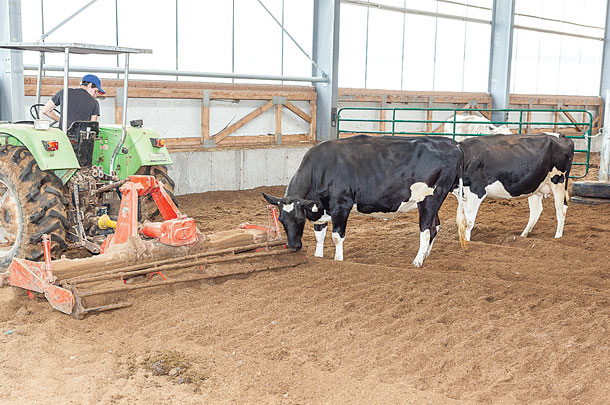
What important tips do you have for dairy producers that might be considering implementing this system?
- Make sure you have a constant and reliable supply of fine, dry hardwood sawdust. Even if you plan on using straw (which should be very fine), you might need to have wood material sometimes to help the process, so it’s important to make sure it’s available.
- Be ready or expect to monitor items, such as temperature and dry matter of the bed, to understand what works well for your barn. The recipe is not the same everywhere.
- You can avoid wetness by not waiting too long before adding new bedding.
- Make sure you plan enough time for working the bed into your daily schedule.
- Visit farms that have had good results in order to see what you should look for (as a result of good composting process).
—Valérie Martin, agr., strategic adviser, and Steve Adam, agr., expert in cow comfort and animal behaviour and well-being, Valacta
PHOTO: Tilling the surface is an option to create a more uniform surface, but deep tillage must continue to be done on a regular basis. Photo courtesy of Valacta.
Read story here: Considerations when choosing a compost-bedded pack system
12. How to prevent digital dermatitis with an effective footbath
Published November 2017
Digital dermatitis (DD) is the most widespread infectious disease causing lameness in herds today.
Traditionally, two products have been and are still used for the footbath – copper sulphate and formaldehyde. However, over the past few years, toxicity problems are of concern due to their intensive use.
In this article, Francois Léveillée, a sales support specialist for DeLaval North America at the time, looked at lactic acid as an alternative product. It is an organic acid that’s gaining more importance in the detergent industry as an antibacterial agent.
Used in a footbath, it will reduce the pH of the water to a level not conductive to bacteria development and will not contribute to the accumulation of heavy metals in the fields or cause a risk to human health.
Field tests have shown lactic acid is just as effective as the traditional footbath solutions, namely copper sulphate and formaldehyde, when used as part of a program to control lameness.
Used in a footbath, lactic acid will reduce the pH of the water to a level not conducive to bacteria development. The solution is effective as long as the footbath’s pH remains low.
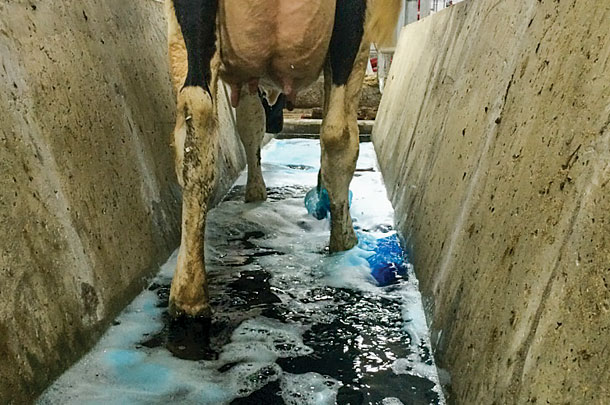
PHOTO: Longer footbaths allow cows to dip all four hooves in the solution. Photo provided by Francois Léveillée.
Read story here: How to prevent digital dermatitis with an effective footbath
13. New location opens up new opportunities for Meilink Dairies Ltd.
Published online
Fifteen years after settling in Alberta from the Netherlands, the Meilink family knew they had limited room to expand at the home farm, so they purchased bare land near Red Deer.
They built a new pre-cast freestall barn with flexible stalls in 2011 with plans to add on a milking parlour in the future.
Meanwhile, Roelof Meilink’s sons, Johnny and Erwin, expressed interest in working on the farm, and they opted instead to retrofit the barn for robots and put in five automated milking units in a free-flow traffic system.
They put the robots inside the barn, added onto the front and back of the barn, and started milking in April 2017. With 265 cows milking, they average 41 litres of milk per cow from 2.8 milkings per day and 4 percent fat.
Last October, they started using genomics. Calves are tested at birth when they receive their eartag.
Roelof says the goal is to raise fewer youngstock and use genomics to help them retain better animals and sell those on the low end. “Raising youngstock is not cheap,” he says.
By reducing the number of animals, they can utilize more of their existing building space.
Read story here: New location opens up new opportunities for Meilink Dairies Ltd.for Meilink Dairies Ltd.
14. Hendriks Dairies Ltd. finds a good fit with Jerseys
Published July 2018
Tyler Hendriks is the third generation to operate Hendriks Dairies Ltd., a family-run operation near Brucefield, Ontario.
He started his business five years ago, purchasing 45 Holstein cows and quota from his uncle, and renting a barn and land.
This barn had tiestalls and a pipeline. Within the year, he switched to Jerseys, finding them a better fit in the old stalls. He also says Jerseys provide greater feed efficiency and possess better health traits.
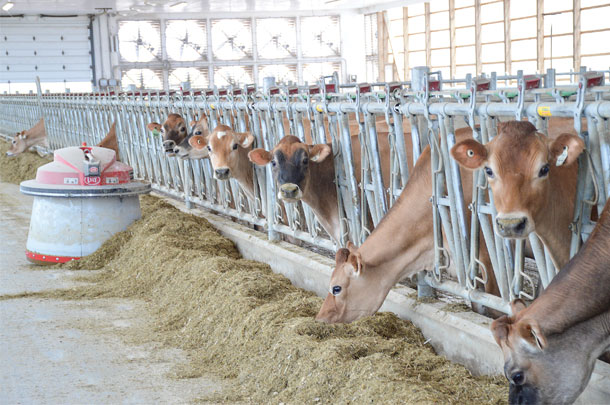
He later converted a former pig barn to quarters for calves and heifers, and built a new freestall barn nearby. This features tunnel ventilation, sand bedding and alley scrapers.
Hendriks installed a double-eight parallel parlour with used stabling that had been originally designed for Holsteins.
Hendriks made the deck shorter and lowered the butt pan to fit the smaller Jerseys. The parlour is equipped with GEA-IQ milkers with automated takeoffs. The new facility was opened in March 2017.
Were you always a fan of Jerseys or did that come after you switched to the breed?
I grew up with Holsteins. When I was 8 years old, we started introducing a few Jerseys and ended up with a 50-50 mixed herd at Dad’s over the years.
When I started on my own a few years ago, I again started with Holsteins. I quickly found the feed efficiency, components and timid nature of the Jersey were what I missed most and made a full switch.
Having a single breed when designing a new barn made it much easier to fit cows into properly designed facilities and not trying to find a middle ground between the two.
From what I’ve seen, Jerseys require 20 to 25 percent less feed. However, they produce only 10 percent less than Holsteins for milk solids. This makes Jerseys a logical choice for your bottom line.
—Tyler Hendriks, dairy producer, Hendriks Dairies Ltd.
PHOTO: After combining his herd with half of his father’s herd, Hendriks outgrew the tiestall facility and built a new freestall barn. His goal is to grow the herd of 110 cows up to 200 as quota availability allows. Photo by Alice Guthrie.
Read story here: Hendriks Dairies Ltd. finds a good fit with Jerseys
15. 3 keys to cow comfort in robotic barns
Published May 2018
At the 2018 Cornell Cow Comfort Conference in Syracuse, New York, Trevor DeVries of the University of Guelph described three essential provisions for achieving peak performance for both cows and robots.
“To ensure cows have the time and desire to milk voluntarily, they need good mobility, comfortable stalls and good access to the milking unit, lying stalls and feedbunk,” he said, backing these conclusions up with research studies on topics such as lameness, stocking density and lying times in voluntary milking systems.
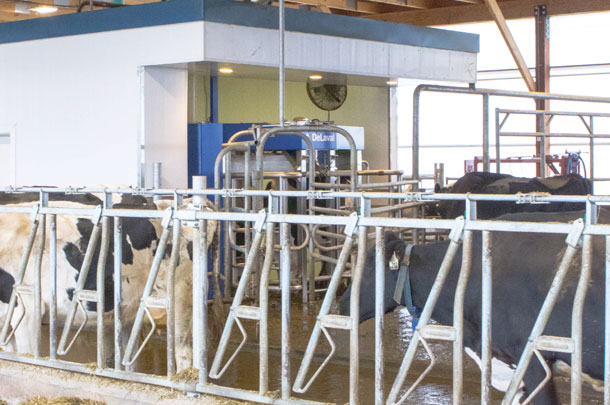
You mentioned evidence feed management affects both lying time and milking time. How can dairy farmers translate this research into action items to improve both cow comfort and robot efficiency?
Dairy cows require good access to feed, water and resting areas. This is particularly true for robot milking barns, whereby inadequate access will negatively impact visits to the robot.
Our research relating feeding management to both lying duration and milking visits in robot barns suggests continuous feed access, across every 24-hour period, is a must.
In addition to ensuring feed is kept fresh, it must also be pushed up at regular intervals across the day and night to ensure anytime a cow is up on her feet and goes to the bunk, there is adequate feed there available to her.
Those push-ups can be done manually; however, if producers cannot do it consistently, and throughout the day and night, they should consider automated methods of doing it for them.
—Trevor DeVries, associate professor, University of Guelph ![]()
PHOTO: “To ensure cows have the time and desire to milk voluntarily, they need good mobility, comfortable stalls and good access to the milking unit, lying stalls and feedbunk.” Photo by Mike Dixon.
Read story here: 3 keys to cow comfort in robotic barns

